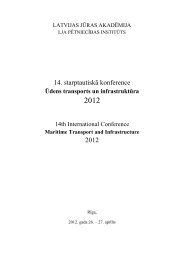Latvian Maritime academy
Latvian Maritime academy
Latvian Maritime academy
Create successful ePaper yourself
Turn your PDF publications into a flip-book with our unique Google optimized e-Paper software.
The mechanical defects in the running slots of the bearing rings, rotating bodies and separators result<br />
in slowing down of the rotor, micro changes of its angular velocity and acceleration, changing in the<br />
space position of rotor in the stator boring. It results in different electromagnetic interaction of rotor and<br />
stator, in the oscillations of rotating electro-magnetic torque. The harmonics (typical frequencies) the<br />
amplitude and frequency of which depend on the technical condition of the bearing unit appear in the<br />
spectrum of the consumed current. The frequency and amplitude of these harmonics are the diagnostic<br />
parameters.<br />
The operating rolling bearing generates mechanical oscillations divisible by basic frequency of<br />
rotation of the three-phase electric motor. These frequencies are called typical.<br />
f = k 1 *f n , (1)<br />
where: f – are the typical frequencies;<br />
k 1 = 1…5 – coefficients;<br />
f n – the typical frequencies when there are defects in the bearings elements. In some cases<br />
coefficient k 1 can get a value within the range 04…-0,8 f n .<br />
The basic characteristics of the spectral analysis of vibro-acoustics as well as the spectral<br />
components of the consumed currents are the frequency and amplitude. 5 typical frequencies, the<br />
amplitudes of which are very different for the bearing unit with defect and for that being defect-free, can<br />
be calculated for the rolling bearing [1, 13].<br />
Figure 1. The basic parameters of the rolling bearings. 4 rolling bodies are conditionally given<br />
f 1 - the rotation frequency of the rotor (of the inside ring of the bearing);<br />
f 2 - the frequency of the rolling of the bearing bodies along the running slots of the outside rings<br />
(Formula 2).<br />
f<br />
1 d4<br />
f3<br />
* Z f1(1<br />
*cos<br />
)* ;<br />
(2)<br />
2 d<br />
2<br />
Z<br />
where:<br />
3<br />
f is the frequency of the separator rotation;<br />
3<br />
d - the diameter of the rolling bodies;<br />
d<br />
4<br />
3<br />
<br />
the diameter of the separator (diameter of the circle going through the centres of the<br />
rotation bodies), and<br />
d<br />
d<br />
d<br />
2<br />
1 2<br />
3<br />
;<br />
d1<br />
- the diameter of the running slot of the outside ring;<br />
d<br />
2<br />
the diameter of the running slot of the inside ring;<br />
α – the angle of the rolling bodies contact with the running slots;<br />
Z- the number of rolling bodies.<br />
10
















